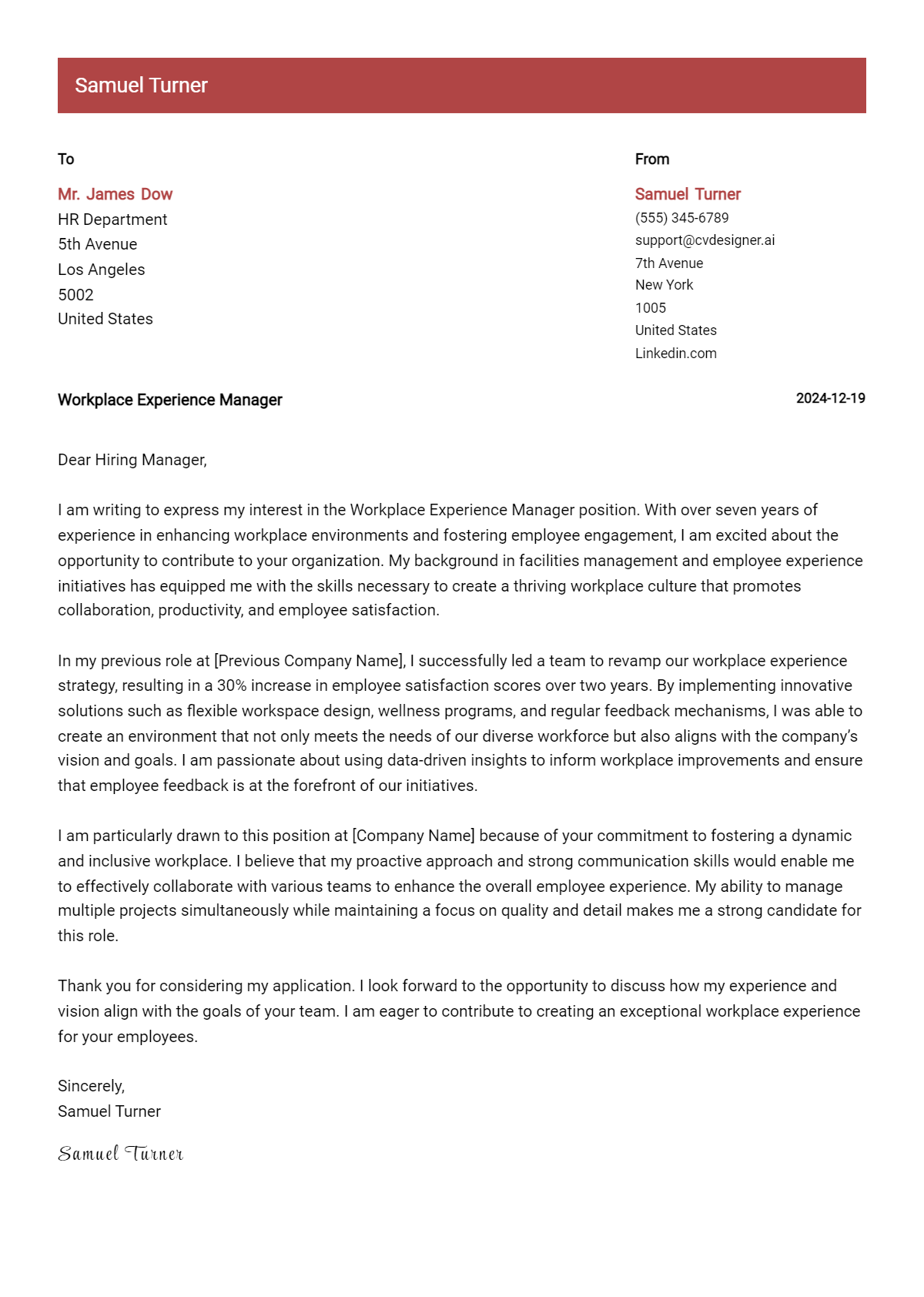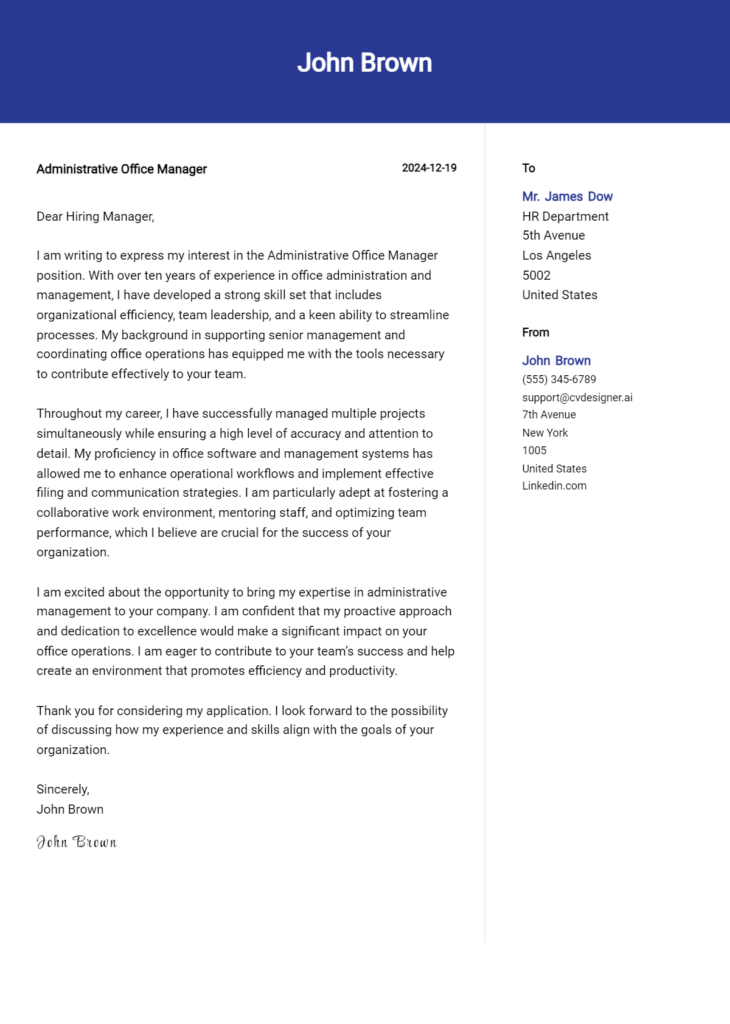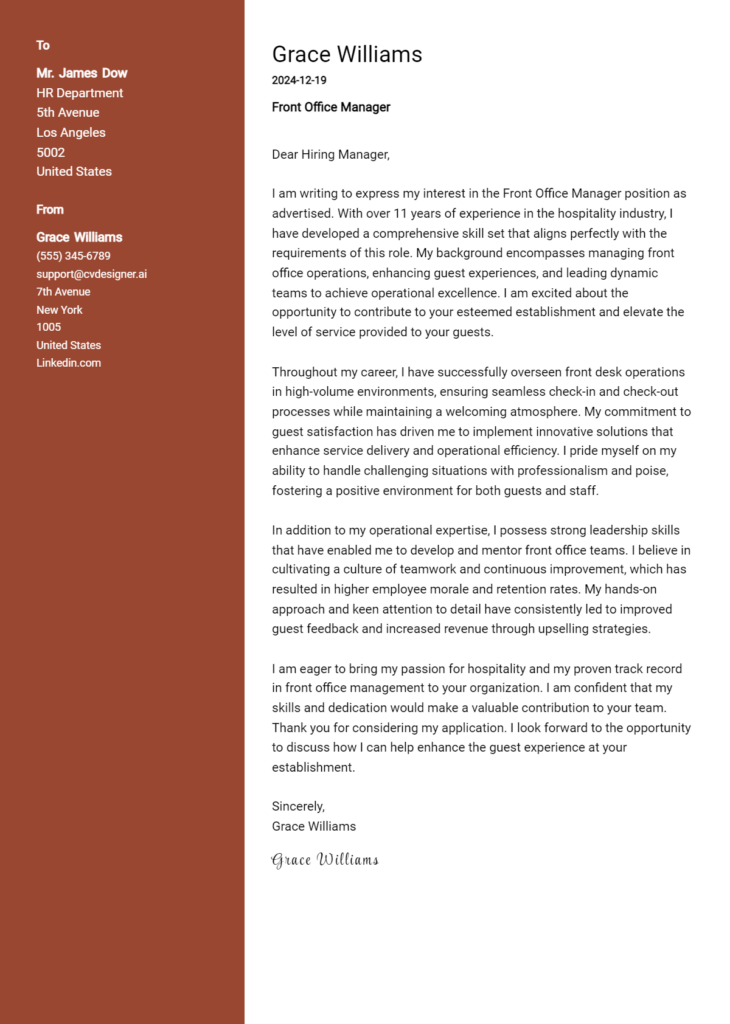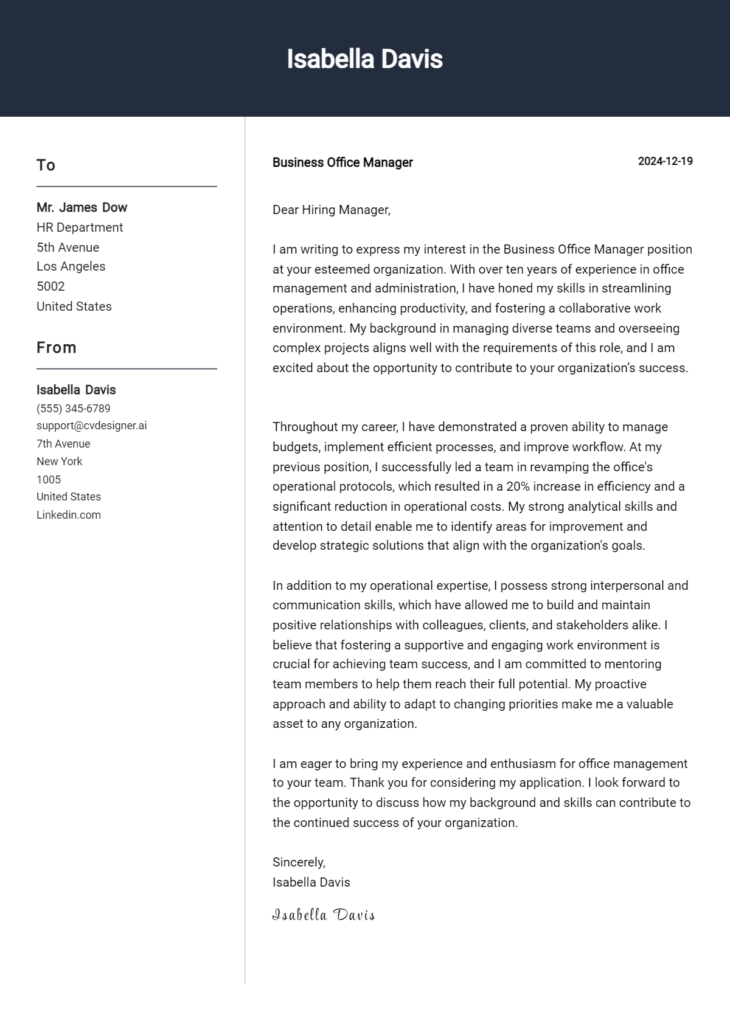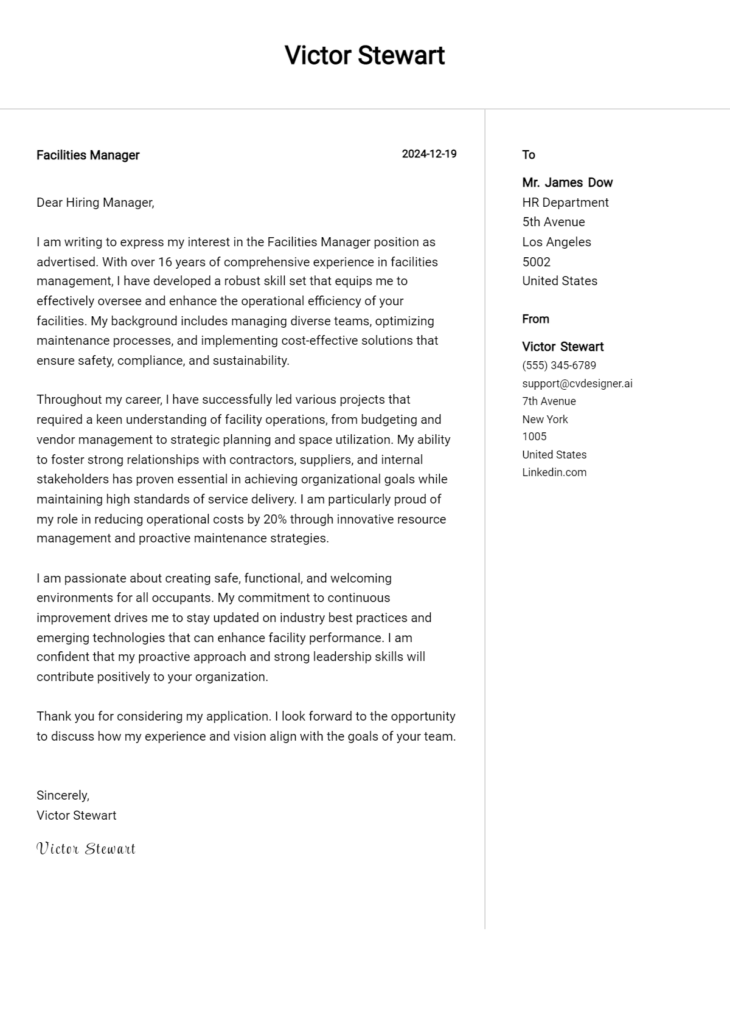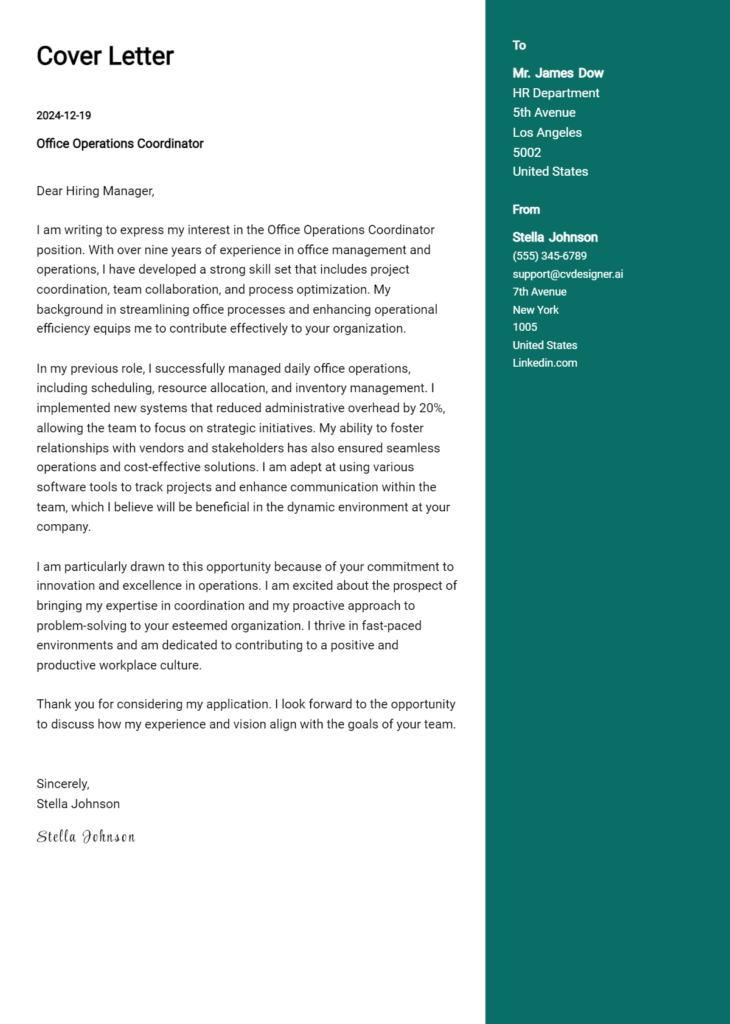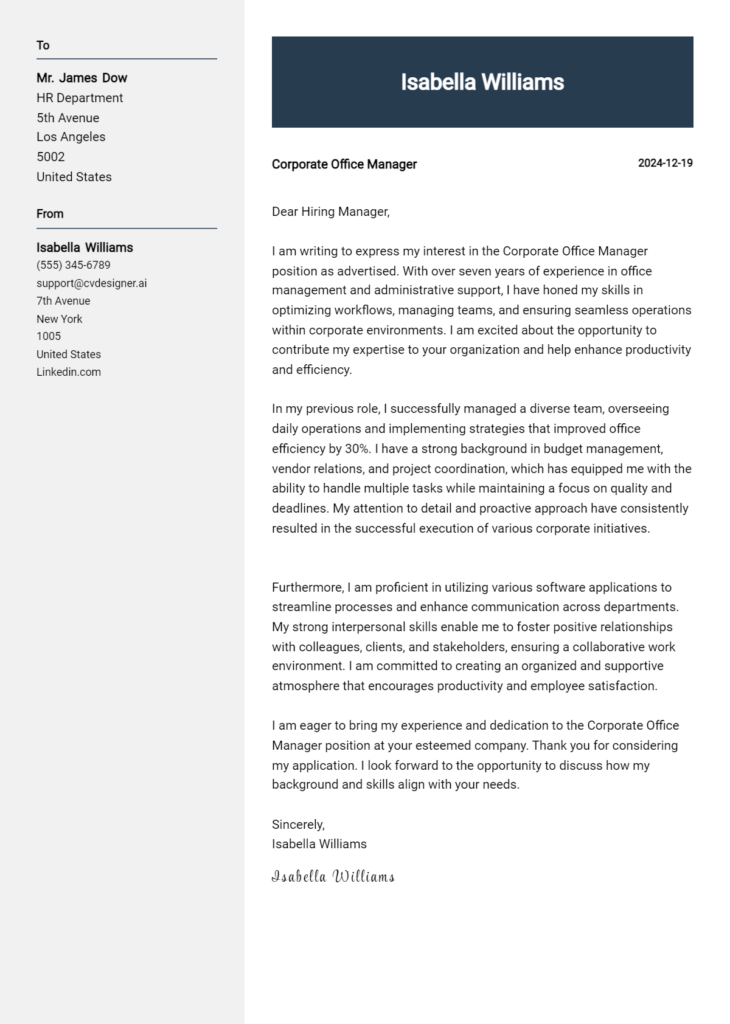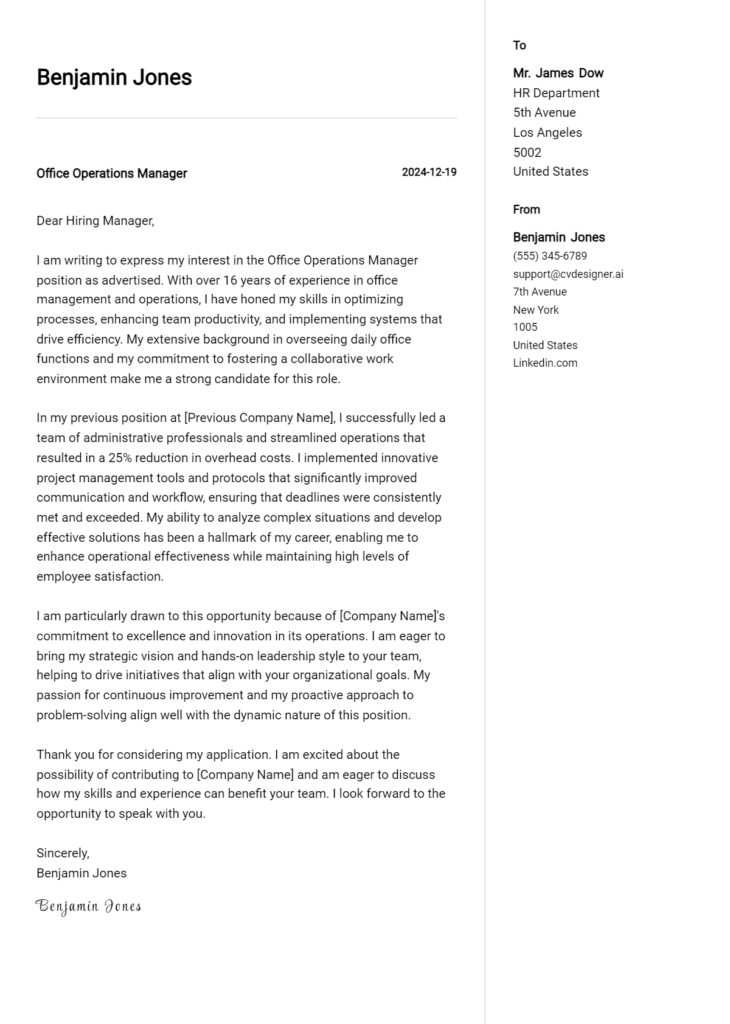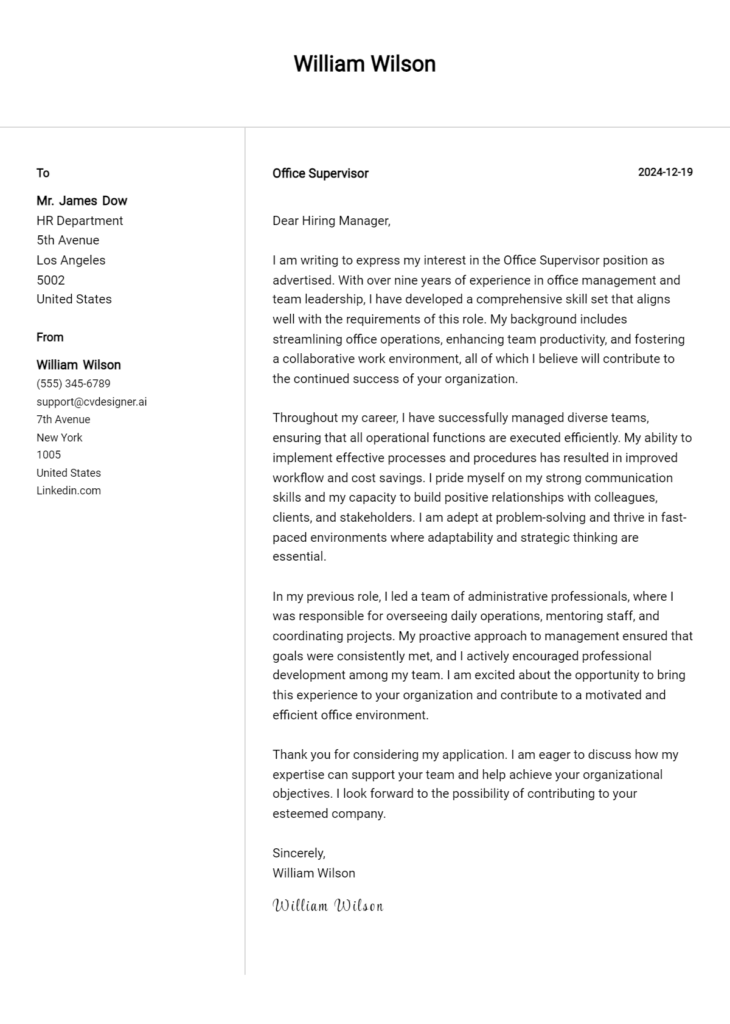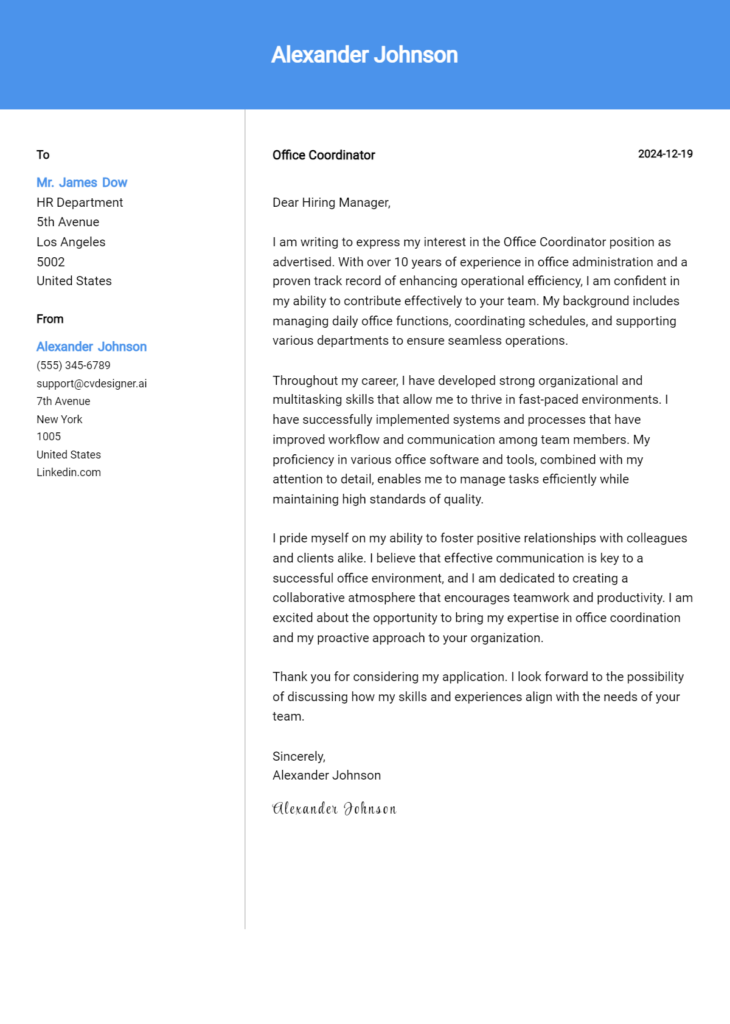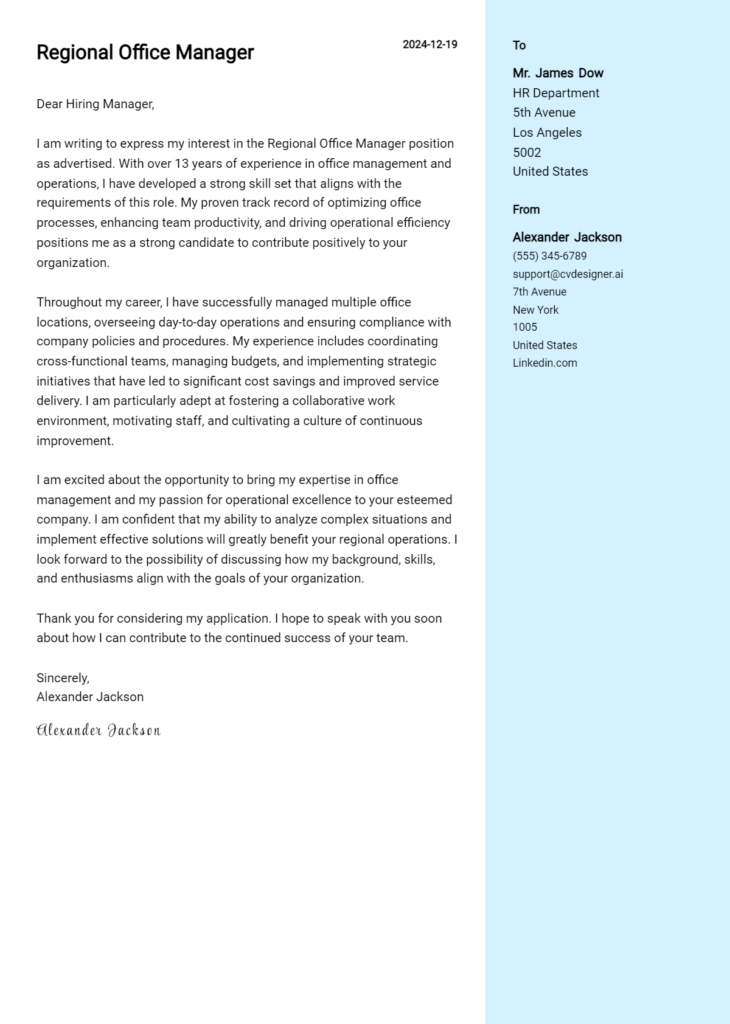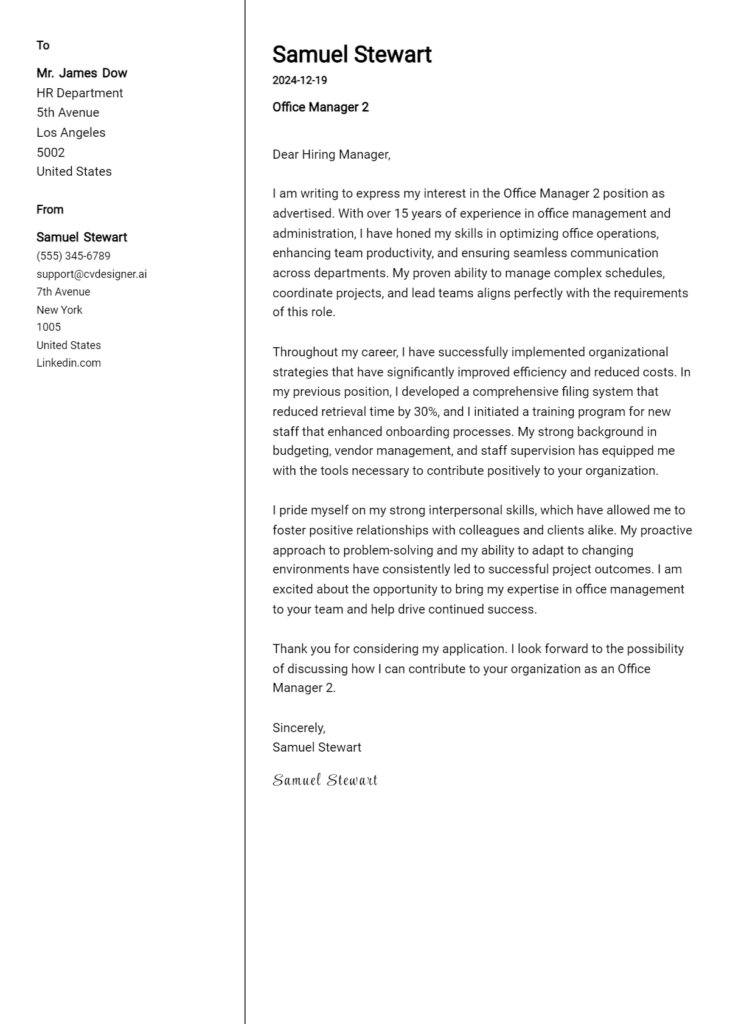Workplace Experience Manager Cover Letter Examples
Explore additional Workplace Experience Manager cover letter samples and guides and see what works for your level of experience or role.
How to Format a Workplace Experience Manager Cover Letter?
Crafting a compelling cover letter is essential for a Workplace Experience Manager, as it reflects your ability to create an engaging and productive work environment. The way you present your skills and experiences not only demonstrates your qualifications but also showcases your understanding of employee satisfaction and organizational culture. Proper formatting helps ensure that your cover letter captures the hiring manager's attention while highlighting your professionalism and attention to detail—crucial traits for a role focused on enhancing workplace experiences.
In this guide, we will outline the key components of a well-structured cover letter, providing insights and specific examples tailored for the Workplace Experience Manager position.
We will focus on the essential components of a professional cover letter, including:
- Cover Letter Header
- Cover Letter Greeting
- Cover Letter Introduction
- Cover Letter Body
- Cover Letter Closing
Each section is vital in emphasizing your qualifications and demonstrating your commitment to creating a positive workplace. Let’s break down each part and explore how to make your cover letter shine.
Importance of the Cover Letter Header for a Workplace Experience Manager
The cover letter header is a crucial component of any professional correspondence, particularly for a Workplace Experience Manager. It sets the tone for the entire document and provides essential information at a glance. A well-structured header includes the applicant's contact information, the date of writing, and the recipient's details. Clarity and professionalism are paramount, as they reflect the candidate's attention to detail and respect for the hiring process. A strong header not only ensures that the letter is easily identifiable but also establishes the applicant's credibility.
Strong Example
John Doe 123 Main Street City, State, Zip Code john.doe@email.com (123) 456-7890 October 1, 2023 Jane Smith Hiring Manager Company Name 456 Business Rd City, State, Zip Code
Weak Example
John D. 10/01/23 To Whom It May Concern
The Importance of the Cover Letter Greeting
The greeting of a cover letter plays a crucial role in establishing the tone for the rest of the letter. It sets the stage for your communication and serves as the first impression for the hiring manager. A well-crafted greeting demonstrates professionalism and a personal touch by directly addressing the recipient, making it clear that you have taken the time to tailor your application. Avoiding generic greetings, such as "To Whom It May Concern," shows initiative and respect for the hiring process. If the hiring manager's name is not readily available, conducting a bit of research can yield valuable information that enhances your greeting.
Here are some tips to keep in mind:
- Always try to find the name of the hiring manager.
- If the name is not available, consider using a general title such as "Hiring Committee" or "Hiring Manager."
- Personalize your greeting to reflect the company's culture and values.
Strong Greeting Example
Dear Ms. Johnson,
Weak Greeting Example
To Whom It May Concern,
Using a strong greeting not only enhances your cover letter's appeal but also demonstrates your commitment to making a positive impression as a Workplace Experience Manager.
The Importance of a Strong Cover Letter Introduction for a Workplace Experience Manager
A compelling cover letter introduction is vital for a Workplace Experience Manager, as it serves as the first impression and can set the tone for the entire application. This introduction should be captivating enough to grab the hiring manager's attention, while also clearly expressing the candidate's interest in the role. Moreover, it should briefly highlight key skills or achievements that align with the job requirements, establishing the candidate's suitability for the position. Below are examples of strong and weak introductions to illustrate how impactful this section can be.
Strong Example
Dear [Hiring Manager's Name], As an accomplished Workplace Experience Manager with over five years of driving employee engagement and enhancing workplace culture, I am excited to apply for the position at [Company Name]. My passion for creating a dynamic and inclusive work environment, combined with my proven track record of implementing innovative solutions to improve employee satisfaction, positions me uniquely to contribute to your team. I am particularly impressed by [specific initiative or value of the company], and I am eager to bring my expertise in strategic planning and stakeholder engagement to further elevate the workplace experience at [Company Name].
Weak Example
To whom it may concern, I am applying for the Workplace Experience Manager position. I have some experience in management and think I could be a good fit. I am interested in working at your company because it seems like a decent place to work.
Purpose of the Cover Letter Body for a Workplace Experience Manager
The body of a cover letter for a Workplace Experience Manager serves as a crucial platform for candidates to present their unique skills, relevant experiences, and overall value proposition to potential employers. This section is an opportunity to articulate how past projects and accomplishments align with the company’s goals and culture. By providing specific examples of initiatives implemented in previous roles—such as enhancing employee engagement through innovative workplace strategies or successfully managing a significant office redesign—candidates can effectively demonstrate their ability to create a positive workplace environment. This tailored narrative not only highlights their expertise in workplace management but also illustrates their commitment to enhancing the employee experience, making them a compelling fit for the organization.
Strong Example
Dear Hiring Manager, I am excited to apply for the Workplace Experience Manager position at XYZ Corporation. In my previous role at ABC Company, I successfully led a project that transformed our office environment, resulting in a 30% increase in employee satisfaction scores. By implementing flexible workspaces and organizing team-building activities, I fostered a culture of collaboration and engagement. Additionally, I managed the integration of a new digital communication tool that streamlined interdepartmental collaboration, significantly reducing project turnaround times. I am eager to bring my expertise in creating vibrant workplace cultures to XYZ Corporation and contribute to your mission of enhancing employee experiences. Sincerely, [Your Name]
Weak Example
Dear Hiring Manager, I would like to apply for the Workplace Experience Manager position. I have some experience in office management and have worked with various teams. I think I could do a good job at your company. I have helped with some projects that involved employee engagement, but I can't recall specific details. I am looking forward to the opportunity to work with you. Best, [Your Name]
Importance of the Cover Letter Closing for a Workplace Experience Manager
The closing paragraph of a cover letter is crucial as it encapsulates your qualifications, reiterates your enthusiasm for the position, and encourages the hiring manager to take the next steps, such as reviewing your resume or scheduling an interview. A strong closing can leave a lasting impression, while a weak one may diminish the overall impact of your application.
Strong Example
Thank you for considering my application for the Workplace Experience Manager position. With my extensive background in enhancing workplace environments and my passion for fostering employee engagement, I am excited about the opportunity to contribute to your team. I believe my skills in strategic planning and collaboration align perfectly with your organization's goals. I look forward to the possibility of discussing my application in further detail and am eager to share how I can help elevate the workplace experience at [Company Name]. Please feel free to contact me to schedule an interview at your convenience.
Weak Example
Thanks for looking at my application. I think I would be okay at the Workplace Experience Manager job. If you want to talk, you can call me or something. Bye.
When applying for the role of a Workplace Experience Manager, a well-crafted cover letter can set you apart from other candidates. This document provides an opportunity to demonstrate not only your technical skills and problem-solving abilities but also your understanding of the Software Development Life Cycle (SDLC), your capacity for teamwork, and your enthusiasm for continuous learning. Here are some tips to help you create an impactful cover letter that highlights these critical areas.
Tips for Crafting an Effective Cover Letter
Highlight Your Technical Skills
Clearly outline your technical expertise relevant to workplace experience management. Whether it’s proficiency in specific software, tools, or methodologies, showcasing these skills will demonstrate your ability to manage the workplace environment effectively. Use concrete examples to illustrate how you've applied these skills in past roles.Demonstrate Problem-Solving Abilities
Employers seek candidates who can identify challenges and propose viable solutions. Share a brief anecdote that illustrates a problem you encountered in a previous job and detail the steps you took to resolve it. This not only shows your analytical skills but also your proactive approach to workplace challenges.Showcase Your Knowledge of SDLC
In the context of a Workplace Experience Manager, understanding the Software Development Life Cycle is crucial, especially if technology plays a significant role in workplace management. Discuss any experience you have with SDLC frameworks and how you applied this knowledge to improve workplace systems or processes.Emphasize Teamwork Experience
Collaboration is key in managing workplace experiences. Provide examples of how you’ve successfully worked within a team to achieve common goals. Describe your role in these collaborations and how your contributions led to improved workplace morale or efficiency.Express Your Passion for Continuous Learning
The workplace landscape is ever-evolving, making a commitment to continuous learning essential. Mention any recent courses, certifications, or workshops you’ve undertaken to enhance your skills. This will reflect your dedication to personal and professional growth, making you a more attractive candidate.
To further enhance your job application, consider utilizing our cover letter templates or a cover letter builder to streamline your writing process. A well-structured cover letter can be a game changer in presenting your candidacy effectively.
Common Mistakes to Avoid in a Workplace Experience Manager Cover Letter
Avoiding common mistakes in your cover letter is crucial for making a strong impression as a Workplace Experience Manager. A well-crafted cover letter can set you apart from other candidates, while errors can undermine your qualifications. Here are some common pitfalls to steer clear of:
Generic Content: Failing to tailor your cover letter to the specific role can make it seem impersonal. Always customize your letter to reflect the job requirements and the company's culture.
Spelling and Grammar Errors: Typos can create a negative impression. Always proofread your letter or use tools to check for errors before submission.
Lack of Specific Examples: Vague statements about your experience can weaken your application. Include specific achievements and metrics to demonstrate your impact in previous roles.
Overly Formal Language: While professionalism is important, overly formal language can make your letter sound stiff. Aim for a conversational tone that still conveys your qualifications.
Ignoring the Format: A cluttered or unorganized cover letter can be off-putting. Follow a clear cover letter format to ensure readability and professionalism.
Focusing Solely on Yourself: While it's important to highlight your skills, neglecting to mention how you can contribute to the company can be a mistake. Show how your experience aligns with the company's goals.
Not Including a Call to Action: Failing to express your desire for an interview can leave your letter feeling incomplete. Conclude with a strong statement inviting further discussion.
By being aware of these common mistakes and following best practices, you can create a compelling cover letter that stands out. For inspiration, check out various cover letter examples to help you craft your own.
Build your Cover Letter in minutes
Use an AI-powered cover letter builder and have your letter done in 5 minutes. Just select your template and our software will guide you through the process.

